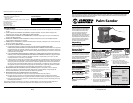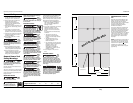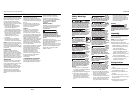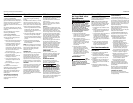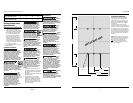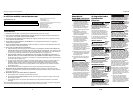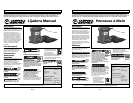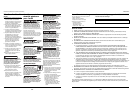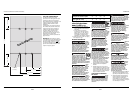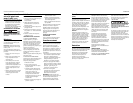
Manual de Instrucciones y Lista de Piezas
18 Sp
Funcionamiento
Las lijadoras manuales están diseñadas
para que la palma de la mano pueda
guiar la herramienta durante el lijado.
Para recoger más polvo, se puede
conectar una aspiradora central
o independiente al orificio de salida
del polvo en lugar en lugar de la bolsa
de recolección de polvo.
1. Comience a lijar seleccionando el
grano más fino apto para el lijado
inicial. El grano debe ser lo
suficientemente grueso como para
quitar la rebaba y la aspereza excesiva.
2. Una vez terminado el lijado inicial
indicado arriba, cambie el papel de
lija por otro con grano un número
más fino (ejemplo: grueso a
mediano), y siga con el proceso
de acabado.
3. Continúe el proceso cambiando
sucesivamente a grano más fino
hasta lograr la terminación deseada.
NOTA: no cambie de un papel de lija
con grano grueso a uno con grano muy
fino en un solo paso. Las marcas
circulares que se puedan haber dejado
con el grano grueso pueden ser difíciles
de eliminar.
LIJADO PLANO
La base de su lijadora efectúa
pequeños movimientos circulares.
Gracias a esto obtendrá una superficie
pareja sin marcas. Como el movimiento
que se realiza es circular, no importa
demasiado cómo sostiene y mueve la
lijadora. Por lo general, no es necesario
aplicar presión adicional a la máquina.
TERMINACIÓN
Revise la superficie a la cual desea dar
el acabado. Si el recubrimiento está
rajado o está pelándose, primero quite
lo más posible con un cepillo o
rasqueta. Luego use un papel de lija
suficientemente grueso para quitar lo
que quede del recubrimiento. Lije la
superficie hasta que quede plana,
elimine todas las manchas y déjela así
lista para una nueva capa de pintura o
barniz.
Mantenimiento
El servicio de la herramienta debe ser
realizado sólo por personal de
reparaciones calificado. El servicio o
mantenimiento realizado por personas
no calificadas puede provocar riesgo de
lesiones.
Si la herramienta no enciende o no
funciona correctamente, devuelva la
herramienta a una instalación de
servicios para repararla.
Limpieza
Limpie el polvo y los desechos de
los orificios y contactos eléctricos,
soplando con aire comprimido.
Los orificios de ventilación del motor
y los interruptores deben mantenerse
limpios y libres de materiales extraños.
No intente limpiarla introduciendo
objetos con punta a través de las
aberturas. Mantenga los mangos de las
herramientas limpios, secos y libres de
aceite o grasa. Use únicamente un
jabón suave y un paño húmedo para
limpiar la herramienta, evitando todos
los contactos eléctricos.
Ciertos agentes de limpieza y solventes
son nocivos para los plásticos y otras
piezas aisladas. Algunos de éstos
incluyen gasolina, aguarrás, solvente
para laca, solvente de pintura,
solventes de limpieza con cloro,
amoníaco y detergentes de uso
doméstico que contengan amoníaco.
Nunca use solventes inflamables ni
combustibles cerca de las
herramientas.
LA HERRAMIENTA NO FUNCIONA
En caso de que la herramienta no
funcione, asegúrese de que la batería
esté cargada e instalada en la sierra.
LUBRICACIÓN
Para su seguridad y protección
eléctrica continuas, la lubricación
y elservicio de esta herramienta
deberán ser realizadas ÚNICAMENTE
por un CENTRO DE SERVICIO
AUTORIZADO DE CAMPBELL
HAUSFELD.
SERVICIO TÉCNICO
Para obtener información con relación
al funcionamiento o reparación de
este producto, sírvase llamar al
1-800-424-8936.
Elservicio de la herramienta debe
serrealizado sólo por personal de
reparaciones calificado. El servicio
omantenimiento realizado por personas
no calificadas puede provocar riesgo de
lesiones.
Al realizarle un servicio a la
herramienta, utilice únicamente piezas
de repuesto idénticas. Siga las
instrucciones de la sección
Mantenimiento de este manual. El uso
de piezas no autorizadas o el no seguir
las instrucciones de Mantenimiento
puede crear un riesgo de choque
eléctrico o lesión.
!
PRECAUCION
POWER TOOL USE AND CARE
Do not
force the
power tool. Use the correct power tool
for your application. The correct power
tool will do the job better and safer at
the rate for which it was designed.
Do not
use the
power tool if the switch does not turn
it on and off. Any power tool that can-
not be controlled with the switch is
dangerous and must be repaired.
Disconnect the plug from the power
source and/or the battery pack from
the power tool before making any
adjustments, changing accessories, or
storing power tools. Such preventive
safety measures reduce the risk of
starting the power tool accidentally.
Store
idle
power tools out of the reach of chil-
dren and do not allow persons unfamil-
iar with the power tool or these
instructions to operate the power tool.
Power tools are dangerous in the
hands of untrained users.
Maintain
power
tools. Check for misalignment or bind-
ing of moving parts, breakage of parts
and any other condition that may
affect the power tool’s operation. If
damaged, have the power tool
repaired before use. Many accidents
are caused by poorly maintained power
tools.
Keep
cutting
tools sharp and clean. Properly main-
tained cutting tools with sharp cutting
edges are less likely to bind and are
easier to control.
Use the
power
tool, accessories and tool bits etc. in
accordance with these instructions,
taking into account the working condi-
tions and the work to be performed.
Use of the power tool for operations
different from those intended could
result in a hazardous situation.
1. This tool must NOT be modified or
used for any application other than
that for which it was designed.
2. Use only accessories that are
recommended by the manufacturer
for your model. Accessories suitable
for one tool may create a risk of
injury when used on another tool.
3
General Power Tool
Safety Warnings
(Cont’d.)
Prevent
uninten-
tional starting. Ensure the switch is in
the off-position before connecting to
power source and/or battery pack, pick-
ing up or carrying the tool. Carrying
power tools with your finger on the
switch or energizing power tools that
have the switch on invites accidents.
Remove
any
adjusting key or wrench before turning
the power tool on. A wrench or a key
left attached to a rotating part of the
power tool may result in personal
injury.
Do not overreach. Keep prop-
er footing and balance at all
times. This enables better
control of the power tool in unexpect-
ed situations.
Dress
properly.
Do not wear loose clothing or jew-
ellery. Keep your hair, clothing and
gloves away from moving parts. Loose
clothes, jewellery or long hair can be
caught in moving parts.
If devices
are pro-
vided for the connection of dust
extraction and collection facilities,
ensure these are connected and prop-
erly used. Use of dust collection can
reduce dust-related hazards.
Do not
misuse
this product. Excessive exposure to
vibration, work in awkward positions,
and repetitive work motions can cause
injury to hands and arms. Stop using
any tool if discomfort, numbness, tin-
gling, or pain occur, and consult a
physician.
1. Always work in a well-ventilated
area. Wear an OSHA-approved dust
mask and safety glasses.
2. Keep hands away from rotating parts.
3. Use clamps or another practical
way to secure the workpiece to a
stable platform. Never hold work in
your hand, lap, or against other
parts of your body when operating
tool.
3. Some wood contains preservatives
which can be toxic. Take extra care
to prevent inhalation and skin
contact when working with these
materials. Request and follow all
safety information available from
your material supplier.
SERVICE
Have
your
power tool serviced by a qualified
repair person using only identical
replacement parts. This will ensure that
the safety of the power tool is main-
tained.
Assembly
Ensure tool is not connected to a
power supply then place tool upside
down on workbench.
NOTE: Use only sanding pads of the
same type, size and weight.
Follow these steps to attach dust
collection bag to the sander’s dust port:
a. Make sure bag is not inside out.
b.Slide collection bag over vacuum
hose with bag support.
c. Pull elastic of bag towards the
vacuum hose. Make sure elastic is
placed in the indentation of
plastic. This ensures a tight fit and
lower risk of bag slippage.
d. Attach bag assembly to dust port
on sander, inserting it until it
bottoms out in the port.
Pre-Operation
BEFORE OPERATING THE TOOL:
1.Always wear ear protectors and dust
mask.
2.Use safety glasses, especially when
you sand above your head.
3.The sander is not suitable for wet
sanding.
4.Check that power switch is not in
the “on” position before you plug in
the power cord.
5.Keep the power cord away from
moving parts of the tools.
www.chpower.com
DG480100CK



